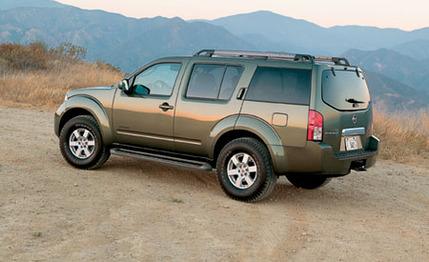 First Drive Review
First Drive Review
When Nissan introduced the Pathfinder for the 1987 model year, it was an immediate success. Competing with the likes of the Chevy S-10 Blazer, Jeep Cherokee, and Toyota 4Runner, the Pathfinder possessed that rare combination of stylish, rugged looks and venerable on- and off-road capabilities. In other words, it had the right stuff-a truck platform, part-time four-wheel drive, available 31-inch tires, and a 3.0-liter V-6-all for about $20,000. Moreover, considering the original featured the widest cargo area in its class, a fashionable three-door design with triangular windows, and a surprisingly car-like ride, it's no wonder it was such a hit.
That success followed the mid-size Pathfinder through the millennium-Nissan sold 68,533 of them in 2000-but since that time, sales have declined, despite the transplant of a 3.5-liter V-6 for '01. In fact, '03 sales of 35,511 slid almost 22,000 units compared with the previous year, far behind those of competitors such as the 4Runner (109,308) and Honda Pilot (106,917). The culprit is competition, of course-mid-size SUVs are roomier, more powerful, and more refined these days, not to mention as plentiful as low-carb candy bars. And age certainly plays a factor-the second-generation Pathfinder is on the final leg of an eight-year tour. Even Macaulay Culkin couldn't stay home alone for that long.
The best way to spur sales and scuttle the competition is with a new model, and no manufacturer knows this better than Nissan. It recently spiced up the full-size-truck pot with the Armada SUV and Titan pickup; now it's adding flavor to the menu of mid-sizers with the SUV shown here and the upcoming Xterra and Frontier.
We had the opportunity to spend a full day behind the wheel of the redesigned, third-generation Pathfinder around Washington's Olympic Peninsula, where we logged over 200 miles both on- and off-road. We found that Nissan's latest ute has significantly improved on its already commendable on-road behavior, as well as successfully upping the ante off-road. Inside, the materials are richer and space is up by 35 cubic feet. Plus, the striking ruggedness of the original has been nicely resurrected in a testosterone-loaded, Armada-like guise that makes its predecessor come across as a wimpy soft-roader.
The basis for the new Pathfinder is a modified version of the F-Alpha platform, a ladder-type assembly that replaces the previous model's unibody. Bones for the Armada and the Titan, the F-Alpha utilizes both high-strength and super-high-strength steel and, unsurprisingly, feels rock solid. Although downsized from the Armada/Titan version, the structure is larger than that of the previous Pathfinder, and that translates into bigger dimensions. Overall length has increased 4.9 inches, width is fatter by 1.1 inches, and the wheelbase has been extended 5.9 inches. Height is up one to two inches. Second-row legroom has stretched 2.4 inches to 34.2, even with the addition of a third row, which raises seating capacity from five to seven.
The rigid structure makes the most of an all-new front and rear unequal-length control-arm suspension, which replaces the previous setup of front struts and a solid rear axle. This setup yields excellent ride quality-on par with the best truck-based utes, e.g., the 4Runner-and handling, aided by four-wheel disc brakes and communicative rack-and-pinion steering, is arguably sporty. Like the Armada, the Pathfinder feels more agile than its size suggests.
Nissan opted not to squeeze a V-8 into the Pathfinder and is instead offering one ballsy V-6. Based on the prior 3.5-liter, the VQ40 displaces 4.0 liters-owing to a stroke 10.6 millimeters longer-and generates 270 horsepower and 291 pound-feet of torque. The new VQ delivers the same horsepower as the V-8 4Runner and 16 more pound-feet than the inline-six Chevy TrailBlazer. Armed with the five-speed automatic lifted from the Armada, the Pathfinder should run from 0 to 60 mph in the low-to-mid-eights. Towing capacity is increased 1000 pounds to 6000.
Off-pavement, the Pathfinder lineup is headlined by the new SE Off-Road 4x4, which comes standard with a two-speed transfer case, hill-descent control, hill-start assist, a four-wheel limited-slip system, 265/75R-16 BFGoodrich tires, Rancho shocks, and 9.2 inches of ground clearance. Nissan engineers claim that compared with the previous Pathfinder, and even the current Xterra, the new ute is superior off-road. We have no reason to doubt them; we had little difficulty traversing a challenging 1.2-mile off-road course replete with boulders, deep ruts, and steep inclines.
The Pathfinder is also available in base XE and luxury-focused LE, both offered with two- or four-wheel drive, as is the SE. Regardless of trim, the Pathfinder features an upscale interior with premium plastics, tasteful analog gauges, flat-folding second- and third-row seats, and available side and curtain airbags. Options include DVD-based navigation and entertainment systems and a Bose six-CD audio system.
Assembled at Nissan's plant in Smyrna, Tennessee, the Pathfinder will hit showrooms about the time you read this. Considering it utilizes an existing platform and is built domestically-even the engine is manufactured in Decherd, Tennessee-pricing should remain at current levels, or about $28,000 to start.
The last time a mid-size SUV from Nissan flaunted such a tasty recipe of good looks, spacious cabin, dexterity on- and off-road, and high value was 18 years ago. See, history does repeat itself.